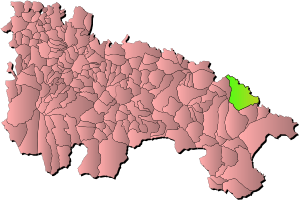Calahorra facts for kids
Quick facts for kids
Calahorra
|
|||
|---|---|---|---|
|
|||

Location within La Rioja.
|
|||
| Country | Spain | ||
| Autonomous community | La Rioja | ||
| Comarca | Rioja Baja | ||
| Area | |||
| • Total | 93.57 km2 (36.13 sq mi) | ||
| Elevation | 358 m (1,175 ft) | ||
| Population
(2009)
|
|||
| • Total | 24,787 | ||
| • Density | 264.903/km2 (686.10/sq mi) | ||
| Time zone | UTC+1 (CET) | ||
| • Summer (DST) | UTC+2 (CET) | ||
Calahorra is an important city in the La Rioja region of Spain. It is located near the border with Navarre, right next to the river Ebro. Long ago, during Roman times, Calahorra was known as Calagurris Fibularia.
Contents
Where is Calahorra Located?
Calahorra sits on a hill about 358 meters (1,175 feet) above sea level. It is located where the Ebro and Cidacos rivers meet. The city covers an area of about 91.41 square kilometers (35.3 square miles). Calahorra is the second-largest city in La Rioja, both in terms of population and importance. Around 21,060 people live there.
A Look Back at Calahorra's History
People have lived in the area where Calahorra is today for a very long time, since the Paleolithic (Old Stone Age). There has been a steady population here since the Iron Age.
Calahorra in Roman Times
The Romans took control of the town in 187 BC. They made it an important center for the surrounding areas. Famous Roman leaders like Julius Caesar and Augustus Caesar helped the city, then called Calagurris, become a municipality.
They improved the city's layout, economy, and politics. Archeological discoveries show that Calahorra had many things found in big Roman cities. These included a circus (for chariot races), baths, and an amphitheatre. The city even made its own money and was a center for justice.
After Roman Rule
After the rule of the Moors in the 9th and 10th centuries, a Christian king named García Sánchez III of Navarre captured the city in 1045.
Calahorra's Sister Cities
Calahorra has special connections with two other cities around the world:
Images for kids
See also
 In Spanish: Calahorra para niños
In Spanish: Calahorra para niños






